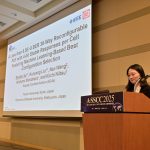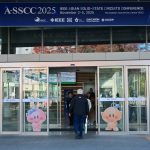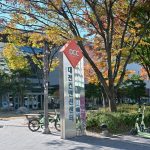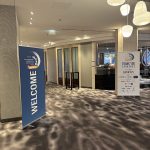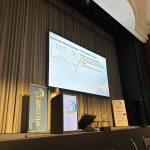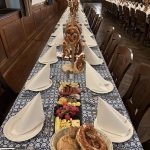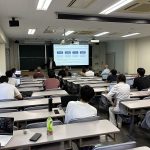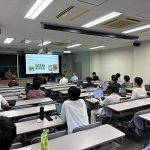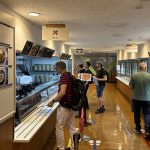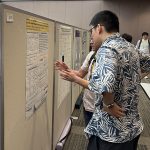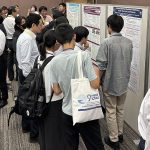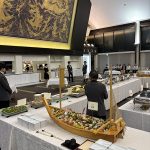IEEE CAS Industrial Distinguished Lectureとして、TSMCデザインテクノロジージャパンの新居浩二様による講演会が開催されました (2025/12/17)。
投稿者: users
技術講演会
2名の著名な集積回路設計技術研究者が講座を訪問し、意見交換を行うとともに、以下の技術講演会を開催しました(2025/11/28)。
Title: Physical Design for Heterogeneous Integration: Challenges and Opportunities
Speaker: Prof. Yao–Wen Chang (National Taiwan University)
Title: Automated Finger Placement for Wire-Bonding Packages Using a Double-Square Analytical Framework
Speaker: Prof. Jai-Ming Lin (National Cheng Kung University)
日本分子生物学会年会
2025年12月3日~12月5日にパシフィコ横浜で開催された第48回日本分子生物学会年会にて、以下のポスター発表を行いました(発表日は12月3日)。
- 小池 健文, 粟野 皓光, 佐藤 高史, “Nanopore Adaptive Samplingの即時制御に向けた波形類似性判定手法,” 日本分子生物学会年会, 2P-048, 2025年12月.
論文採択 ISSCC 2026
以下の論文がISSCC 2026に採択されました。2026年2月にサンフランシスコで成果を発表します。
S. Xu*, K. Liu*, L. Chan, H. Tagawa, H. Shinohara, K. Niitsu, “A Sub-Threshold All-nMOS Reconfigurable PUF with Secure Configuration Selection for Stable 6-Bits/Cell,” Technical Digest of International Solid-State Circuits Conference (ISSCC), to appear. (*ECAs)
Q. Cheng*, Z. Yang*, H. Li, Q. Li, Z. Kong, G. Niu, Y. Liang, J. Li, J. Yoo, M. Hashimoto, and L. Lin, “A Radiation-Hardened Self-Healing Cmos Imager with Online Pixel/Logic Annealing and Tile-Adaptive Compression for Space Applications,” Technical Digest of International Solid-State Circuits Conference (ISSCC), to appear. (*ECAs)
論文採択 DATE 2026
以下の論文がDATE 2026に採択されました。2026年4月にイタリアのヴェローナで成果を発表します。
- Quan Cheng, Haoyuan Li, Wang Liao, Feng Liang, Longyang Lin, Masanori Hashimoto, “Gohan: A Golden-Copy-Aided Platform Enabling Online Hybrid-Interactive Reliability Analysis,” Proc. DATE, to appear.
- Quan Cheng, Haoyuan Li, Zhenzhe Chen, Wang Liao, Jing-jia Liou, Masanori Hashimoto, Longyang Lin, “Ramen: Radiation-Aware Modeling Framework for PDK-Enabled Design and Library Characterization,” Proc. DATE, to appear.
IEEE A-SSCC 2025
2025年11月2日から11月5日に韓国の大田広域市で開催された IEEE Asian Solid-State Circuits Conference (IEEE A-SSCC 2025)において、D3の徐さんが研究成果の発表を行いました (発表日は11/3)。
- Shufan Xu*, Kunyang Liu*, Nan Wang, Hirofumi Shinohara and Kiichi Niitsu, “A Less than 6.5E−8 BER 36-Way Reconfigurable PUF with 4-bit Stable Responses per Cell Featuring Machine Learning-Based Best-Configuration Selection,” in Proceedings of IEEE Asian Solid-State Circuits Conference (A-SSCC), Daejeon, South Korea, Nov. 2025, pp.103-105. (*Equally Credited Authors)
ICCAD2025
2025年10月26日から10月31日にドイツのミュンヘンで開催された International Conference on Computer-Aided Design (ICCAD 2025)において、橋本, Guo が研究成果の発表を行いました (発表日はそれぞれ10/27, 10/28)。
- Quan Cheng, Huizi Zhang, Chien-Hsing Liang, Mingtao Zhang, Jing-Jia Liou, Jinjun Xiong, Longyang Lin and Masanori Hashimoto, “Tenpura: a General Transient Fault Evaluation and Scope Narrowing Platform for Ultra-Fast Reliability Analysis,” in Proceedings of International Conference on Computer-Aided Design (ICCAD), pp.1-6, Oct. 2025.
- Xinyi Guo, Geguang Miao, Shinichi Nishizawa, Hiromitsu Awano, Shinji Kimura, and Takashi Sato, “SOME: Symmetric One-Hot Matching Elector — A Lightweight Microsecond Decoder for Quantum Error Correction,” in Proceedings of International Conference on Computer-Aided Design (ICCAD), pp.1-6, Oct. 2025.
IEEE SENSORS 2025
2025年10月19日から22日にカナダのバンクーバーで開催されたIEEE SENSORS 2025において、M2の定くんと白井先生が以下の論文の発表を行いました(発表はいずれも10/20)。
- R. Sada, T. Tanaka, H. Asaue, T. Shiotani, M. Hashimoto, and R. Shirai, “Localization of Embedded Sensors in Reinforced Concrete Via Time-Series Magnetic Field Sensing and Maximum Likelihood Estimation,” IEEE Sensors Letters, to appear.
- R. Fukugasako, H. Asaue, T. Shiotani, M. Hashimoto, and R. Shirai, “A Current Chopper-Assisted Magnetic Field-Based Backscatter Communication Method with WPT Overcoming Ultra-Low Coupling Coefficients,” IEEE Sensors Journal, volume 25, number 10, pages 18249-18256, May 2025.
FAU大学来訪・講演会
2025年9月30日から10月2日まで、ドイツFriedrich-Alexander-Universität Erlangen-Nürnberg(FAU大学)よりJürgen Teich教授の研究グループが我々の研究室を訪問し、研究交流を行いました。9月30日にはFAU大学が、10月1日には京都大学が主に発表をするセミナーを開催し、活発に議論を行いました。
SASIMI2025
2025年10月9日〜10月10日に奈良市で開催されたThe 26th Workshop on Synthesis And System Integration of Mixed Information Technologies(SASIMI2025)において、以下の発表を行いました(発表日はLi, Sekiが9日、Utsunomiyaが10日)。
- Ryuto Seki, Masami Utsunomiya, Haoyuan Li, Hiromitsu Awano, and Takashi Sato, “LMESN: A low-power hardware reservoir computing architecture based on MOSFET leakage variation,” in Proc. Workshop on synthesis and system integration of mixed information technologies (SASIMI), pp.115-120, October 2025.
- Masami Utsunomiya, Hiroya Murata, Ryuto Seki, Haoyuan Li, Hiromitsu Awano, and Takashi Sato, “Accelerated behavioral simulation for optimizing MOSFET-based echo state networks,” in Proc. Workshop on synthesis and system integration of mixed information technologies (SASIMI), pp.290-295, October 2025.
- Haoyuan Li, Masami Utsunomiya, Ryuto Seki, Takashi Sato, and Feng Liang, “EMESN: An extended MOSFET reservoir computing architecture for echo state networks with hardware-software co-optimization,” in Proc. Workshop on synthesis and system integration of mixed information technologies (SASIMI), pp.103-108, October 2025.




